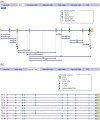ASPIC: a web resource for alternative splicing prediction and transcript isoforms characterization
- PMID: 16845044
- PMCID: PMC1538898
- DOI: 10.1093/nar/gkl324
ASPIC: a web resource for alternative splicing prediction and transcript isoforms characterization
Abstract
Alternative splicing (AS) is now emerging as a major mechanism contributing to the expansion of the transcriptome and proteome complexity of multicellular organisms. The fact that a single gene locus may give rise to multiple mRNAs and protein isoforms, showing both major and subtle structural variations, is an exceptionally versatile tool in the optimization of the coding capacity of the eukaryotic genome. The huge and continuously increasing number of genome and transcript sequences provides an essential information source for the computational detection of genes AS pattern. However, much of this information is not optimally or comprehensively used in gene annotation by current genome annotation pipelines. We present here a web resource implementing the ASPIC algorithm which we developed previously for the investigation of AS of user submitted genes, based on comparative analysis of available transcript and genome data from a variety of species. The ASPIC web resource provides graphical and tabular views of the splicing patterns of all full-length mRNA isoforms compatible with the detected splice sites of genes under investigation as well as relevant structural and functional annotation. The ASPIC web resource-available at http://www.caspur.it/ASPIC/--is dynamically interconnected with the Ensembl and Unigene databases and also implements an upload facility.
Figures



Similar articles
-
ASmodeler: gene modeling of alternative splicing from genomic alignment of mRNA, EST and protein sequences.Nucleic Acids Res. 2004 Jul 1;32(Web Server issue):W181-6. doi: 10.1093/nar/gkh404. Nucleic Acids Res. 2004. PMID: 15215376 Free PMC article.
-
ECgene: genome annotation for alternative splicing.Nucleic Acids Res. 2005 Jan 1;33(Database issue):D75-9. doi: 10.1093/nar/gki118. Nucleic Acids Res. 2005. PMID: 15608289 Free PMC article.
-
EuSplice: a unified resource for the analysis of splice signals and alternative splicing in eukaryotic genes.Bioinformatics. 2007 Jul 15;23(14):1815-23. doi: 10.1093/bioinformatics/btm084. Epub 2007 Mar 7. Bioinformatics. 2007. PMID: 17344236
-
Computational methods for alternative splicing prediction.Brief Funct Genomic Proteomic. 2006 Mar;5(1):46-51. doi: 10.1093/bfgp/ell011. Epub 2006 Feb 20. Brief Funct Genomic Proteomic. 2006. PMID: 16769678 Review.
-
Genome-wide analyses of alternative splicing in plants: opportunities and challenges.Genome Res. 2008 Sep;18(9):1381-92. doi: 10.1101/gr.053678.106. Epub 2008 Jul 30. Genome Res. 2008. PMID: 18669480 Review.
Cited by
-
ASPic-GeneID: a lightweight pipeline for gene prediction and alternative isoforms detection.Biomed Res Int. 2013;2013:502827. doi: 10.1155/2013/502827. Epub 2013 Nov 7. Biomed Res Int. 2013. PMID: 24308000 Free PMC article.
-
Survey of Programs Used to Detect Alternative Splicing Isoforms from Deep Sequencing Data In Silico.Biomed Res Int. 2015;2015:831352. doi: 10.1155/2015/831352. Epub 2015 Sep 3. Biomed Res Int. 2015. PMID: 26421304 Free PMC article. Review.
-
Integrated de novo transcriptome of Culex pipiens mosquito larvae as a resource for genetic control strategies.Sci Data. 2024 May 9;11(1):471. doi: 10.1038/s41597-024-03285-1. Sci Data. 2024. PMID: 38724521 Free PMC article.
-
Alternative RNA splicing in stem cells and cancer stem cells: Importance of transcript-based expression analysis.World J Stem Cells. 2021 Oct 26;13(10):1394-1416. doi: 10.4252/wjsc.v13.i10.1394. World J Stem Cells. 2021. PMID: 34786151 Free PMC article. Review.
-
Identification of tumor-associated cassette exons in human cancer through EST-based computational prediction and experimental validation.Mol Cancer. 2010 Sep 2;9:230. doi: 10.1186/1476-4598-9-230. Mol Cancer. 2010. PMID: 20813049 Free PMC article.
References
-
- Matlin A.J., Clark F., Smith C.W. Understanding alternative splicing: towards a cellular code. Nature Rev. Mol. Cell Biol. 2005;6:386–398. - PubMed
-
- Okazaki Y., Furuno M., Kasukawa T., Adachi J., Bono H., Kondo S., Nikaido I., Osato N., Saito R., Suzuki H., et al. Analysis of the mouse transcriptome based on functional annotation of 60 770 full-length cDNAs. Nature. 2002;420:563–573. - PubMed
-
- Stamm S., Ben-Ari S., Rafalska I., Tang Y., Zhang Z., Toiber D., Thanaraj T.A., Soreq H. Function of alternative splicing. Gene. 2005;344:1–20. - PubMed
-
- Venables J.P. Aberrant and alternative splicing in cancer. Cancer Res. 2004;64:7647–7654. - PubMed
Publication types
MeSH terms
Substances
LinkOut - more resources
Full Text Sources
Molecular Biology Databases
Research Materials

